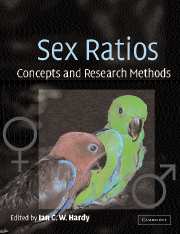Book contents
- Frontmatter
- Contents
- List of contributors
- Preface and acknowledgements
- Part 1 Sex ratio theory
- Part 2 Statistical analysis of sex ratio data
- Chapter 3 Statistical analysis of sex ratios: an introduction
- Chapter 4 Analysis of sex ratios in social insects
- Chapter 5 Analysis of sex ratio variances and sequences of sex allocation
- Chapter 6 Comparative analysis of sex ratios
- Part 3 Genetics of sex ratio and sex determination
- Part 4 Animal sex ratios under different life-histories
- Part 5 Sex ratios in plants and protozoa
- Part 6 Applications of sex ratios
- Index
- References
Chapter 3 - Statistical analysis of sex ratios: an introduction
Published online by Cambridge University Press: 06 August 2009
- Frontmatter
- Contents
- List of contributors
- Preface and acknowledgements
- Part 1 Sex ratio theory
- Part 2 Statistical analysis of sex ratio data
- Chapter 3 Statistical analysis of sex ratios: an introduction
- Chapter 4 Analysis of sex ratios in social insects
- Chapter 5 Analysis of sex ratio variances and sequences of sex allocation
- Chapter 6 Comparative analysis of sex ratios
- Part 3 Genetics of sex ratio and sex determination
- Part 4 Animal sex ratios under different life-histories
- Part 5 Sex ratios in plants and protozoa
- Part 6 Applications of sex ratios
- Index
- References
Summary
Summary
In this chapter we discuss how to make best use of sex ratio data. We identify three basic questions that such data can be used to answer: does the sex ratio differ from some theoretically expected mean value, does it differ from an expected distribution and is variation in sex ratio associated with some measured explanatory terms? Our main focus is on the latter question. We discuss analytical methods in order of ‘sophistication’, starting with nonparametric methods (which make few assumptions about underlying statistical distributions), then classical parametric methods (which assume that data conform to a normal distribution of deviations from a statistical model) and finally generalized linear models (GLMs). GLMs are semi-parametric methods that encompass models assuming a normal distribution but may also assume other distributions. This is an important advantage as sex ratio data are best expressed as proportions (sex ratio = males/(males + females)) and deviations are expected to conform to a binomial distribution. GLMs assuming binomial distributions are often termed logistic regression models. Distributions may not conform to the normal or binomial assumptions of classical parametric analyses or logistic GLMs, and we discuss how these problems can be overcome. The statistical approaches we discuss are illustrated with worked examples and case histories from recent sex ratio literature. We also perform simulations to evaluate the relative performances of nonparametric, classical parametric and logistic GLM analyses: GLMs win.
Information
- Type
- Chapter
- Information
- Sex RatiosConcepts and Research Methods, pp. 48 - 92Publisher: Cambridge University PressPrint publication year: 2002
References
Accessibility standard: Unknown
Why this information is here
This section outlines the accessibility features of this content - including support for screen readers, full keyboard navigation and high-contrast display options. This may not be relevant for you.Accessibility Information
- 322
- Cited by
